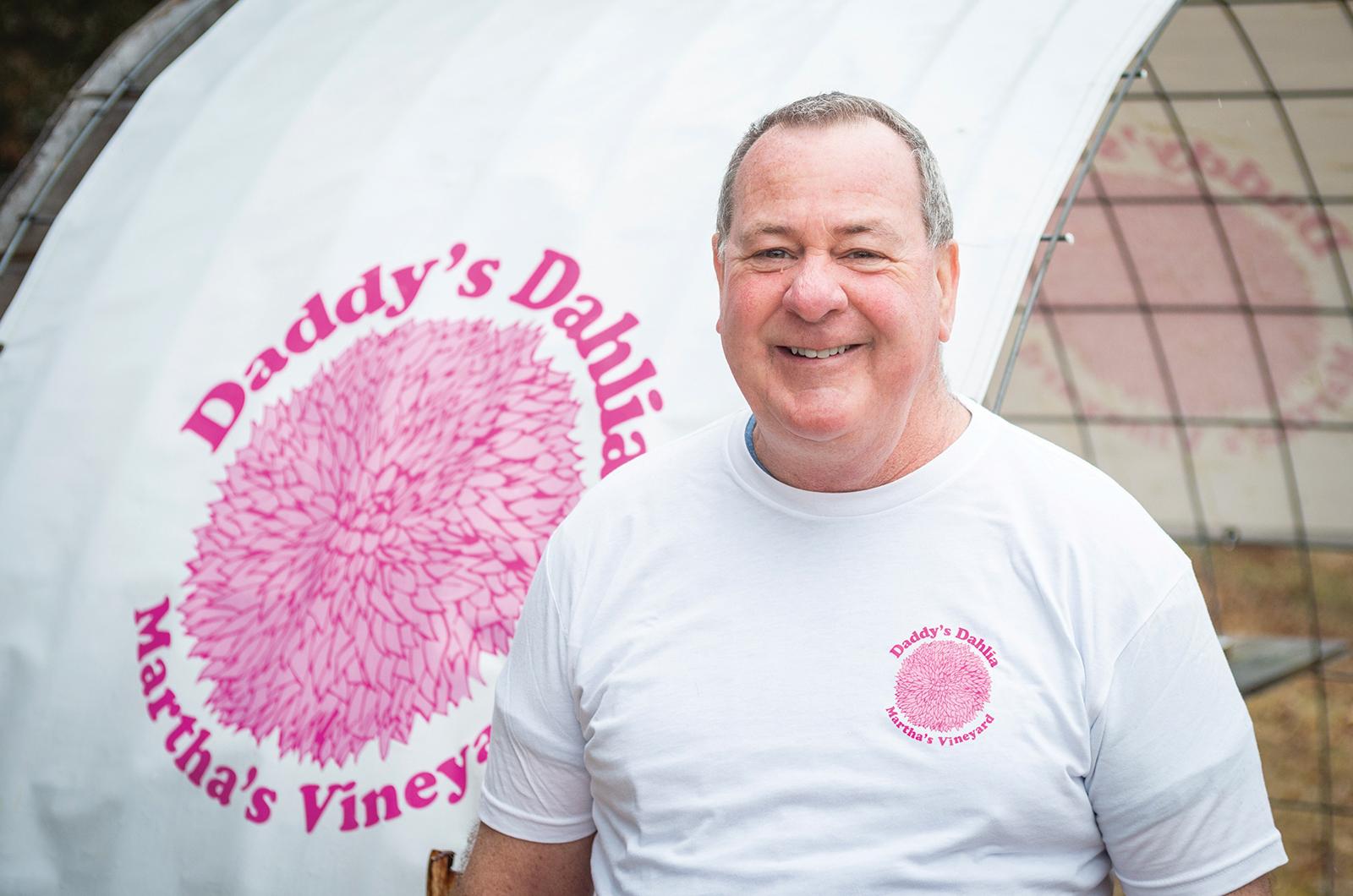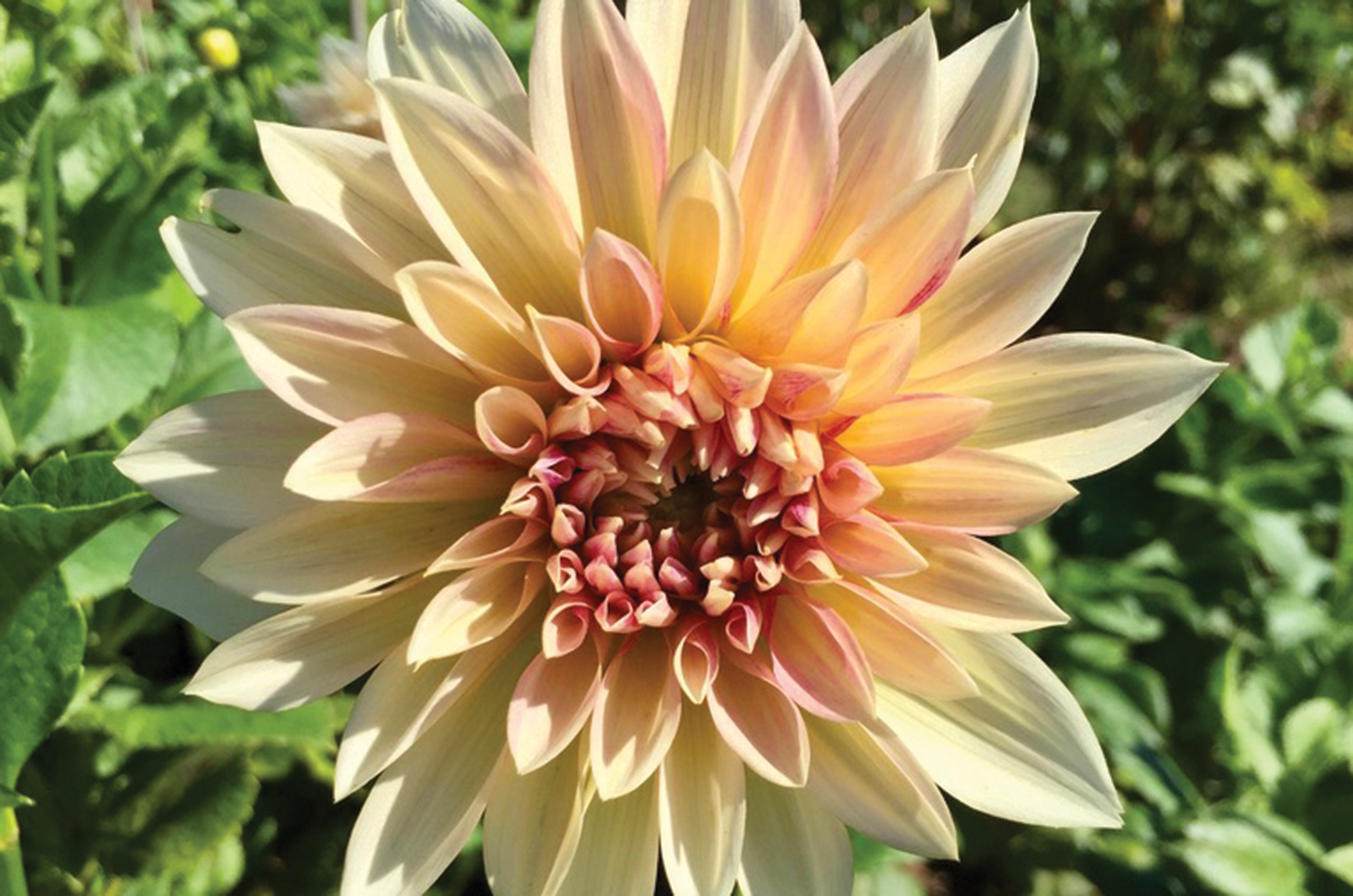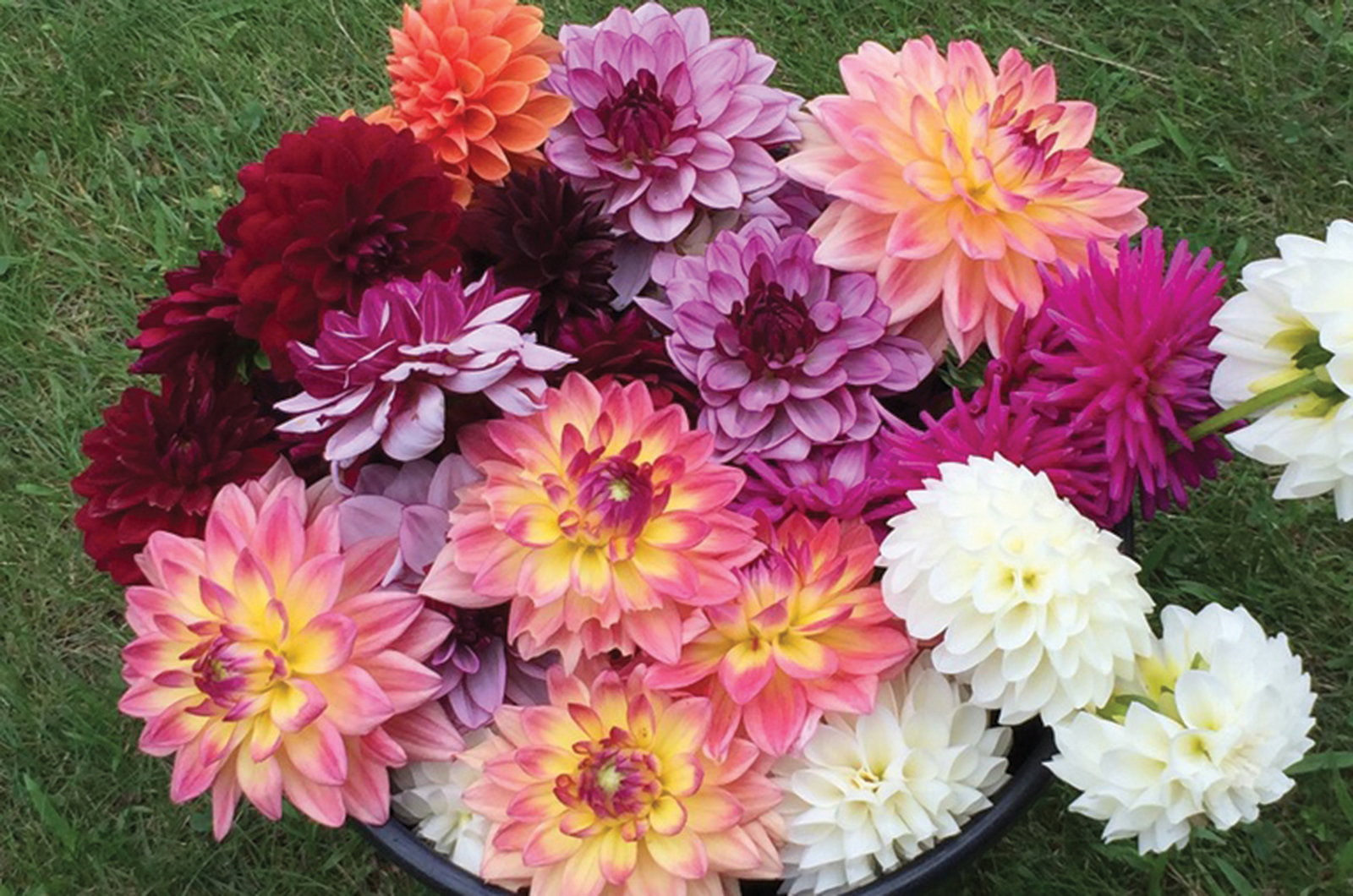On Martha’s Vineyard, few flowers capture the Island’s late-summer beauty quite like dahlias. Renowned etiquette expert and summer resident Emily Post was known for her vibrant dahlia blooms as large as pie plates on Fuller Street – an Edgartown curb appeal still in place a century later.
In the height of summer, on the way home from South Beach, I have often taken a detour-worthy route to pick from the colorful buckets at Daddy’s roadside stand on Clevelandtown Road, now an Island summertime fixture. But it wasn’t until I wandered into a blues night at The Pawnee House in Oak Bluffs last October that I finally put a face to ‘Daddy.’ There, behind the soulful harmonica, Jim Carnazza was pouring his heart into the blues – just as he does into his dahlias, which he was generously giving away to patrons that night.
With a scientist’s curiosity and a musician’s soul, Jim has turned his love of dahlias into both an art and a science. What began as a passion project has blossomed into a thriving “cottage” industry, with his stunning blooms gracing farmers’ markets, hotel lobbies, and restaurants. If you catch him and his group, BlueSwitch, performing during dahlia season, you might just leave with a bouquet of his flowers and a favorite new blues band!
I sat down with Jim to talk about his journey to the Vineyard, what drew him to dahlias, and the art (and science) of growing these stunning flowers.
Q. What first brought you to the Vineyard?
A. Well it’s funny, we summered in East Falmouth when I was a kid and I remember sitting on the beach at night watching those ferries go across and wondering what it was all about! Fast forward to my college years and I was working summers tagging lobsters for John Hughes at the Hatchery and for Manny Correllus at the State Forest. [Named Manuel F. Correllus State Forest in his honor in 1955.] Manny was the funniest guy who loved to tell stories, especially about John F. Kennedy and his dealings with the Department of the Interior.
Q. Those are classic Vineyard experiences which I imagine made you want to stay.
A. It was the simple beauty of the Island. And, of course, the fishing. You know, the Vineyard in the late ‘70s was a very, very cool place – and it still is. In Edgartown, the Colonial Inn and Lou’s Worry, where Rockfish is today, were the hubs. The Colonial Inn even had a Japanese garden with little bridges over the water – the perfect spot to try and steal a kiss! Now as a musician I just love the Island music scene and the music community.
Q. When did you and your wife, Cory, decide to make the Island your home?
A. We were living in Holden, Mass., and I ran a molecular lab for 35 years – a company I started based on sequencing genetics. My wife’s family is from the Vineyard. She has an old Vineyard name, Vose. We were actually staying at her grandparents’ house in Wellesley while they were here for the summer. They had the Vineyard Gazette delivered, and one day we opened it up and saw a $5,000 house that needed to be moved. That’s how we got our foothold here and our first house. But I’m also related to the Vineyard. My ancestor, Benjamin Hoar, was a whaling captain and carpenter on Chappaquiddick in the late 1600’s.
Q. When did you establish Clevelandtown Road and dip your toe into the soil for growing dahlias?
A. We got a really good deal on a house on Clevelandtown Road with an extra building lot, which turned out to be a farm. I’d tried growing roses in Holden for years because I love flowers, but it didn’t go well – too much heavy frost. Tried again here, but it didn’t go well. Then my wife said, “Hey, have you ever heard of dahlias?” And I was like, “No!” And she said, “Try dahlias!”
Q. What made the dahlias take?
A. The soil on our property. When they came to rip out all the bittersweet and other stuff, the guy running the machine said, “This is really unusual – you’ve got about four feet of topsoil.” He digs for a living and had never seen such beautiful topsoil. We looked it up in the annals at the Martha’s Vineyard Museum, and it turns out the property was a dairy farm for 35 years with 16 milkers. Those cows were raised right there. I was like, “Wow, this is great!” And the way the sun hits the field is perfect. If you stand in my field, it’s 15 degrees warmer than other places around. So that first year, I planted 400 dahlias just laying them out in rows, and now I’m up to 1,500 to 1,800 on a 100’ x 80’ space.
Q. So you have this lucky break, you’ve got the sun and this incredible soil, but there still must have been a lot to learn.
A. Yes. There was the whole cycle to learn. When the tubers come out of the ground, they get divided, washed, cleaned, and stored in sand and vermiculite. I do 75 percent sand, 25 percent vermiculite, mixed up in a wheelbarrow. Then I throw them into a plastic bag, seal it completely, and store them in cardboard beer boxes in my basement. The cellar temperature stays between 40 and 55 degrees. If it drops below 32 degrees, they can freeze. The dahlia itself acts just like a potato. It has an eye that throws up an apical meristem, which will grow into a plant. If they get too moist, they rot; if they get too dry, they shrivel.
Q. Do you start some of the plants over the winter? Do you have a greenhouse?
A. Yes, I start with about three dahlias in a pot – around 400 total for my first batch, say, 1,200 dahlias. I also use my greenhouse, and I section off part of my basement with plastic sheeting. I have a heater and multiple fluorescent grow lights on a timer, and the same for temperature, water, and fertilization. It’s a lot of work, but my goal is to get blooms by June 15 to keep things moving and make some money. I start the pots in February, hoping they don’t get too leggy. When I transplant them, it’s like landing a plane – you have to hit that runway just right for the best success.
Q. How was last year’s crop and how does that result influence your strategy this year?
A. Last year was a bad year – everything was late, and I made much less money. I can’t really tell you why; it seemed like it rained fine, but everyone was saying the same thing – things were slow to come. But I was also picking flowers until late November. This year I plan on getting my greenhouse plants in between May 1 and May 15.
For the home gardener, I think the goal should be to have blooms to cut by the end of July, so plant the tubers when you plant your tomatoes. Wait for those beautiful late spring days when everything’s blooming, it’s green, and you can smell the mulch and dirt. Get yourself a thermometer. We want the soil to be about 60 degrees, and then put a bamboo stake right at the head of the tuber so you know where you planted it. The first shoots should come up in about three weeks – but some varieties won’t send up a shoot for three to five weeks.
Q. Is it now set-and-forget the tubers in the beds – watching our bamboo stakes for the first signs of shoots?
A. I suggest for the first three weeks you do not water them – which is a hard thing for most people, but if the tuber gets soggy it rots and you get nothing. As soon as you start seeing green come up, give it a little water and fertilizer. Don’t use Miracle Gro® – the nitrogen is too strong. You want the nitrogen to be the lowest percentage of the three numbers you see on the package, something like 5-10-10. I get rose fertilizer at Granite and use my hose feeder.
Q. I read that dahlias have a fascinating genetic profile with eight sets of chromosomes, which allows for a huge variety of colors and some genetic drift. As a scientist in genetics, does that influence your approach to growing dahlias?
A. It’s a legitimate question, but I don’t pay much attention to it. With eight chromosomes, yeah, they can revert back to their original color if they were cloned or had another mother stalk. I had this beautiful
Prince of Orange – a big medallion, bright orange, just lovely! But many I planted last year reverted to a five-petal, daisy-like bloom. Dahlias can surprise you. I’ve been happy that most of my bread-and-butter dahlias, like the off-white Café au Lait (the bride’s favorite) and the Burgundy wine-colored Crème de Cassis, are coming in as I hope.
Q. How many of those happy stems do you cut and deliver to your roadside stand and to your clients?
A. When I deliver to The Charlotte Inn or to the Hob Knob, each bucket has about 25 to 35 stems: the big, yellow Kelvin Floodlight, the smaller, dark purple Arabian Night, and the bi-colored Melody Dora, which is my champion with its four-inch bloom. I put 160 of those in, and I’m usually cutting about 150 stems per week on that variety, 100 on others. The deep, rich Babylon Red – new last year – was a winner. I really recommend Babylon Red for beginners.
Q. I love your website tagline, “Fresh Cut Happiness.” Your customers must light up when they see you coming!
A. Honestly, people are just blown away. They start laughing when I arrive. I tell them, “I didn’t make that flower that beautiful.” I do everything I can and I’m not super religious, but I tell them, “It’s God who does this.”
Sissy Biggers is the Q&A columnist for The Vine and a contributor to Martha’s Vineyard Magazine.




 1 comment
1 comment









Comments (1)
Comments